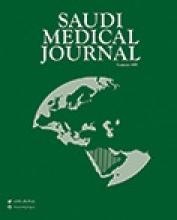Abstract
OBJECTIVE: To assess the diagnostic accuracy of clinical diagnosis versus echocardiography in evaluating childhood heart murmurs.
METHODS: We investigated 107 children under the age of 10 years with heart murmurs admitted to 3 hospitals in Baghdad (Al-Khadimyiah Pediatric Hospital, Al-Karama Teaching Hospital/Pediatric Department and Al-Noor Teaching Hospital/Pediatric Department) during the period of January 1998 to January 2002. Data on age, gender, provisional clinical diagnosis and final echocardiographic diagnosis were taken. Statistical analysis through Chi-square was carried out.
RESULTS: There were more males than females (58.9% versus 41.1%, p<0.05). Provisionally, diagnoses of pathological murmurs were made in 88.8% of patients compared with 11.2% for innocent murmurs. The most common pathological murmur was that of ventricular septal defect (58.9%) and the least was aortic stenosis (1.9%). Echocardiographically, pathological findings were seen in 62.6% of patients compared with 37.4% for normal results. Provisional and echocardiographic diagnoses were concordant in 52.3% of patients and discordant in 47.7%, a difference of highly statistical significance (p<0.001). The most common concordant and discordant diagnoses were ventricular septal defect and innocent murmurs.
CONCLUSION: Though echocardiography can be used to precisely evaluate heart murmurs, the role of comprehensive history taking and meticulous physical examination must not be neglected. Defect in specific accuracy of clinical acumen noted by the pediatricians who cared for the studied patients probably reflects their different standards in medical education and clinical training. Developing and implementing advanced physical diagnosis curriculum, establishing training programs in cardiology for pediatricians and provision of well-trained pediatric echocardiographers seem crucial. These options will eventually contain medical expenses.
- Copyright: © Saudi Medical Journal
This is an open-access article distributed under the terms of the Creative Commons Attribution-Noncommercial-Share Alike 3.0 Unported, which permits unrestricted use, distribution, and reproduction in any medium, provided the original work is properly cited.






